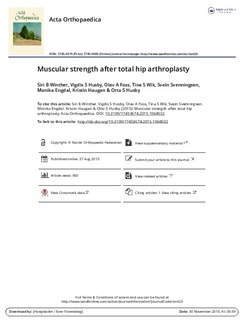| dc.contributor.author | Winther, Siri Bjørgen | |
| dc.contributor.author | Husby, Vigdis Schnell | |
| dc.contributor.author | Foss, Olav Andreas | |
| dc.contributor.author | Wik, Tina Strømdal | |
| dc.contributor.author | Svenningsen, Svein | |
| dc.contributor.author | Engdal, Monika | |
| dc.contributor.author | Haugan, Kristin | |
| dc.contributor.author | Husby, Otto Schnell | |
| dc.date.accessioned | 2015-11-30T14:13:15Z | |
| dc.date.accessioned | 2015-12-01T09:29:00Z | |
| dc.date.available | 2015-11-30T14:13:15Z | |
| dc.date.available | 2015-12-01T09:29:00Z | |
| dc.date.issued | 2015 | |
| dc.identifier.citation | Acta Orthopaedica 2015, 86(6) | nb_NO |
| dc.identifier.issn | 1745-3682 | |
| dc.identifier.uri | http://hdl.handle.net/11250/2366340 | |
| dc.description.abstract | Background and purpose — Minimizing the decrease in muscular strength after total hip arthroplasty (THA) might allow patients to recover faster. We evaluated muscular strength in patients who were operated on using 3 surgical approaches.
Patients and methods — In a prospective cohort study, 60 patients scheduled for primary THA were allocated to the direct lateral, posterior, or anterior approach. Leg press and abduction strength were evaluated 2 weeks or less preoperatively, 2 and 8 days postoperatively, and at 6-week and 3-month follow-up.
Results — Differences in maximal strength change were greatest after 2 and 8 days. The posterior and anterior approaches produced less decrease in muscular strength than the direct lateral approach. 6 weeks postoperatively, the posterior approach produced greater increase in muscular strength than the direct lateral approach, and resulted in a greater increase in abduction strength than the anterior approach. At 3-month follow-up, no statistically significant differences between the groups were found. The operated legs were 18% weaker in leg press and 15% weaker in abduction than the unoperated legs, and the results were similar between groups.
Interpretation — The posterior and anterior approaches appeared to have the least negative effect on abduction and leg press muscular strength in the first postoperative week; the posterior approach had the least negative effect, even up to 6 weeks postoperatively. THA patients have reduced muscle strength in the operated leg (compared to the unoperated leg) 3 months after surgery. | nb_NO |
| dc.language.iso | eng | nb_NO |
| dc.publisher | Taylor & Francis | nb_NO |
| dc.title | Muscular strength after total hip arthroplasty. A prospective comparison of 3 surgical approaches | nb_NO |
| dc.type | Journal article | nb_NO |
| dc.type | Peer reviewed | en_GB |
| dc.date.updated | 2015-11-30T14:13:15Z | |
| dc.source.volume | 86 | nb_NO |
| dc.source.journal | Acta Orthopaedica | nb_NO |
| dc.source.issue | 6 | nb_NO |
| dc.identifier.doi | 10.3109/17453674.2015.1068032 | |
| dc.identifier.cristin | 1295221 | |
| dc.description.localcode | © 2015 The Author(s). Published by Taylor & Francis on behalf of the Nordic Orthopedic Federation. This is an Open Access article distributed under the terms of the Creative Commons Attribution-Non-Commercial License (https://creativecommons.org/licenses/by-nc/3.0) DOI 10.3109/17453674.2015.1068032 | nb_NO |
